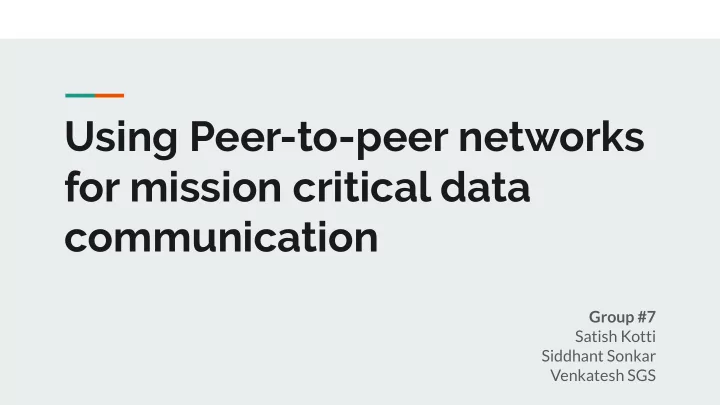

Using Peer-to-peer networks for mission critical data communication Group #7 Satish Kotti Siddhant Sonkar Venkatesh SGS
Introduction Peer-to-peer based approach for data transmission in mission critical systems like disaster ● response systems. Properties: ● Large number of recipients ○ Disseminate as fast as possible ○ Reach maximum number of nodes ○ Heterogeneous network ○ Fault Tolerance ○ Applications: ● Disaster Response Systems ○ Emergency Alert Systems ○
Related Work Various methodologies can be employed to solve the problem of flash dissemination. ● Conventional centralized client server setting ● Single point of failure ● Can be optimized for performance and improved latency ●
Reliable Multicast Application Layer Multicast ● Core of the algorithm is to build a spanning tree. ● Trade off Stretch for Stress. ● Various approaches that use this paradigm . ● Scalable Application layer multicast ○ Farecast ○ Overcast ○ Not suitable for high volume of topology changes ● Not as scalable as P2P ● Need dedicated infrastructure ● P2P is more reliable ● Not as fault tolerant as P2P ● P2P is more cost-effective ●
Tree-based Multicast Need information of network topology ● Constant changes to topology need to re-estimate the tree continuously ● Failure of nodes within the tree structures impacts the performance of the network ●
Peer to Peer approaches Randomized approaches. E.g. Gossip, Random Walk etc. ● Decentralized algorithm ● Prefer redundancy and reliability over scalability. ● Under the assumption that our content is not very huge, gossip protocols are well suited for our ● use case. Flash dissemination scenarios are unpredictable and may contain heterogeneous networks, ● randomized approaches tackle this scenario better. Operate with local knowledge. ● Heuristics for obtaining global knowledge can help improve the performance and reduce ● dissemination time.
Project Simulation Centralized Architecture ● Gossip Network ● Random-walk based Gossip Network ●
Gossip-based Architecture Centralized Architecture
Centralized Architecture Source node informs the cloud ● Cloud publishes the message to a message queue (ZeroMQ) ● All subscribers to the broadcasting topic receive information ●
Gossip Network Connection handshake with the bootstrapper node. ● Socket information exchanged. Used for subsequent message transmission. ● Connection details added to connection pool, happens asynchronously in different processes. ● All live nodes establish connection with bootstrapper node. ● A new connection at bootstrapper is informed about previous connections. ● Nodes use this data to identify peers and establish connection. ● Messages are broadcasted to all the members of connection pool. ● Every node receiving the message, broadcasts the message to the neighbours other than the ● source.
Random-walk Gossip Networks Messages are broadcasted to randomly chosen subset of connections. ● Helps with controlling flooding in the network ● Not suitable for small networks. Can cause starvation for few nodes. ●
DEMO
Evaluation Number of nodes = { 3, 5, 8, 10, 15, 20, 30 } ● Used 4 laptops and 1 android device to simulate 5 nodes ● Repeated the experiment multiple times to generate a pool of average latency values ● Used these values for further simulation (delay time + code snippet run time) ●
Results Nearly same values for centralized architecture ● RPC consuming more time ● Sockets are quick ● Flooding in gossip started causing delay quickly ● Surprisingly, gossip and random-walk got nearly ● same results Scaling to 100 nodes can clearly signify ● importance of random-walk.
Future Work Varying Content Size ● Heterogeneous content - images, video, text ● Varying Network Bandwidth ● Modeling Network Topology ● Rapid Packet Loss ○ Network Partitions ○ Failing nodes and links ○ High network churn rate ○
Supporting tools for future work Network Simulation ● ModelNet ○ Planet Lab ○ NS-3 ○ Protocol Simulation ● Cooja Contiki ○ CupCarbon ○
Challenges & learnings Challenges ● Network Simulation at scale with tools ○ Realistic simulation - Google Cloud, Kubernetes ○ No good documentation for available implementations ○ Learnings ● Low level socket programming ○ Protocol implementation and simulation ○ Understanding necessity for multi-threaded implementations in such systems - maintaining mutex locks on ○ connection pools, spawning a process for each activity, importance of asynchronous behaviour
Thank you!
Recommend
More recommend